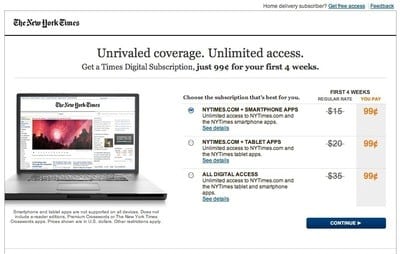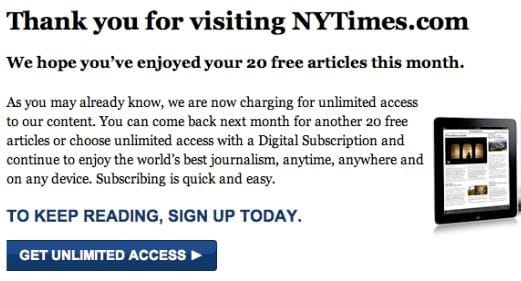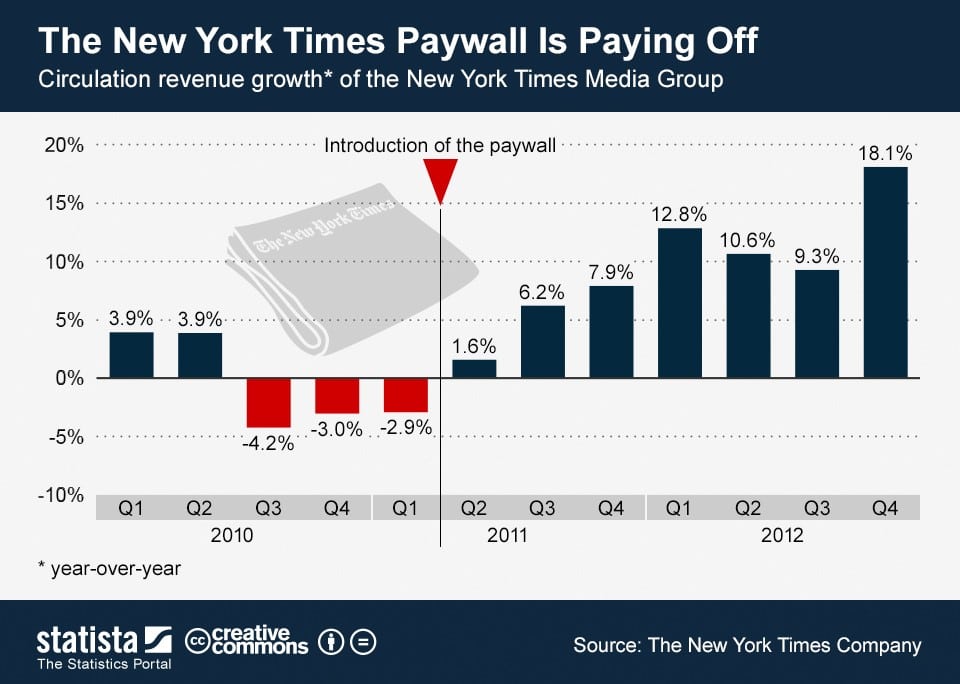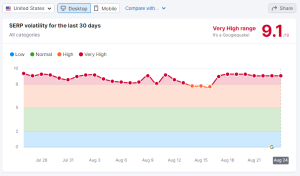Google has recently made changes to their recommendations for websites that have content aimed at subscribers that can also be found by Search Engine Bots. Besides ads, subscriptions are one of the top ways that content focused websites (news organizations, blogs) generate revenue.
In this model, Googlebot crawls a website and is able to see content that is hidden behind a “paywall”. This content is indexed and shows up in the SERP. When a user clicks on the site, instead of seeing the content of the website, a prompt appears letting the user know that the content is available for subscribers only.
For example, a news site may publish an article about a recent event. Googlebot crawls the page and adds that page into it’s index. Users searching for news about the event will find this page in the search results page and click into it. What they see is not the content but a pop up letting the user know that the content can only be accessed when they pay a subscription fee.

Paywalled Content Can Look Like Cloaking
The problem with this behavior, in Google’s eyes, is that the content that Google sees is different than what the user sees. This is known as cloaking, an old spam tactic where users would present the search engine bots with content and show users ads, porn, pills or something else not relevant to what the user expected by clicking on the link in the SERP. This practice goes against Google’s Guidelines, a set of best practices for creating websites that are search engine friendly.
The issue that Google had to address was how to let websites that had paywalls continue to rank for their content while also giving users the confidence that when they click on a result, they will find the content they expect from following the link in the SERP.
The Introduction of First Click Free
The way that they solved this is through an initiative named First Click Free (FCF). The way that first click free works is that when a user clicks on a link from the search results page, they will find the content promised by the link. If the user clicks on another story or post within the website, the next page will show the paywall prompt, asking for a subscription.
This gets around the cloaking problem by showing the user the same content that the bots would see. This also allow the user to sample the content of a site before having to make the decision to subscribe and see more of the content on the site.
The First Click Free model for displaying sample content to a user worked generally, but was found to sometimes degrade user experience, which would lead to behaviors, which could lead to negative ranking performance.
“…while FCF is a reasonable sampling model, publishers are in a better position to determine what specific sampling strategy works best for them. Therefore, we are removing FCF as a requirement for Search, and we encourage publishers to experiment with different free sampling schemes, as long as they stay within the updated webmaster guidelines.
We call this Flexible Sampling.”
What is Flexible Sampling?
Flexible sampling is a name given to multiple types of sampling models that webmasters can test in order to have the most beneficial impact on user experience, while still obeying Google’s Guidelines. Google replaced their page on First Click Free with the updated page detailing Flexible Sampling models and guidance.
“There are two types of sampling we advise: metering, which provides users with a quota of free articles to consume, after which paywalls will start appearing; and lead-in, which offers a portion of an article’s content without it being shown in full.”
Metering
Metering is when a website allows a user to view a number of articles or posts within a set period of time before the user hits a paywall. The benefit with metering over first click free is that a user can have a more natural experience akin to a subscribed user. Under the First Click Free model, and second page visited would prompt the user to subscribe. With metering, a user may navigate around the same website viewing 10-20 pages before getting that prompt.

Lead-In
Lead-in is when a website shows the user a part of the article or post (100 words or a paragraph) and truncates the rest with a call to action telling the user to subscribe to see the rest. While First Click Free blocks the user from viewing any of the content on a page, lead-in sampling allows a user to get a taste of what the content is before inviting the user to subscribe.
Which Sampling model is right for you?
If you own a website that is content focused and runs on subscriptions, you know that paywalls are integral to the life of your business model. The New York times went from multiple quarters of negative circulation growth before their implementation of a paywall.

Deciding on the type of flexible sampling that is right for your website should come from a place of data and testing. Google’s research has shown that users that see a paywall more than 10% of the time for a user are far less likely to convert.
“Our analysis shows that general user satisfaction starts to degrade significantly when paywalls are shown more than 10% of the time (which generally means that about 3% of the audience has been exposed to the paywall). We recommend caution in approaching that limit, because you may start to alienate users who have not yet become convinced of the value of your content.”
Depending on what flexible sampling model you use, Google recommends that you inform them of the model through structured markup. You can view the different ways to implement structured markup for paywalled/subscription content on their Structured Data markup page. Below are some links that will help you get started implementing flexible sampling on your website.
- Google Webmaster Central Blog – Announcement of Flexible Sampling
- Google Webmaster Guidelines – Best Practices for Implementing Flexible Sampling
- Google Developers – Subscription and Paywalled Content Structured Data Markup Instructions



